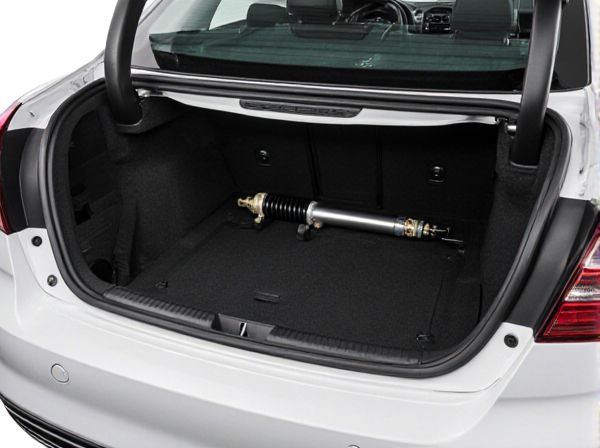
Photo illustration: Powered Lift Mechanism vs Hydraulic Strut
A powered lift mechanism utilizes motors and gears to provide controlled and adjustable lifting force, ensuring precise movement and positioning. Hydraulic struts rely on fluid pressure to absorb shock and support weight, offering smooth and consistent lifting with minimal effort. Your choice between the two depends on the need for exact control versus simplicity and reliability in lifting applications.
Table of Comparison
| Feature | Powered Lift Mechanism | Hydraulic Strut |
|---|---|---|
| Operation Type | Electric motor-driven | Gas or fluid pressure-driven |
| Opening Speed | Fast, controlled | Moderate, natural |
| Effort Required | Minimal, push-button | Manual or assisted lift |
| Load Capacity | High, supports heavy trunks | Moderate, depends on strut size |
| Maintenance | Periodic motor checks | Low, occasional leak checks |
| Durability | Long-lasting with electronic parts | Reliable, fewer mechanical parts |
| Cost | Higher installation and repair costs | Lower initial and maintenance costs |
| Common Use | Premium and luxury vehicles | Standard and mid-range vehicles |
Introduction to Powered Lift Mechanisms and Hydraulic Struts
Powered lift mechanisms utilize motor-driven actuators to provide precise control and smooth movement in lifting applications, commonly found in automotive hoods, trunks, and industrial equipment. Hydraulic struts operate through fluid pressure to offer robust support and controlled damping, enhancing stability and safety in lifting tasks such as vehicle lift gates and heavy machinery panels. Both technologies optimize ergonomic efficiency and reliability but differ in complexity, energy consumption, and maintenance requirements.
Fundamental Working Principles
A powered lift mechanism operates using electric motors or actuators to generate controlled mechanical motion for lifting or positioning applications, providing precise and adjustable movement through electronic controls. Hydraulic struts rely on pressurized fluid within cylinders to create force and absorb shock, using Pascal's principle to transfer energy and support loads with smooth, dampened motion. Both systems convert energy into mechanical work, but powered lifts emphasize electrical energy and control accuracy, while hydraulic struts utilize fluid dynamics for force modulation and stability.
Key Components and Materials Used
Powered lift mechanisms primarily utilize electric motors, gears, and linkages made from high-strength steel or aluminum alloys to provide precise and efficient movement control. Hydraulic struts consist of a cylinder, piston, and fluid reservoir, typically constructed from corrosion-resistant steel with seals made from synthetic rubber or polyurethane to ensure durability and leak prevention. Both systems rely on materials engineered for strength, wear resistance, and lightweight properties to optimize performance in automotive or aerospace applications.
Performance Efficiency Comparison
Powered lift mechanisms deliver superior performance efficiency by offering precise control and consistent lifting power through electric motors, resulting in faster operation and reduced energy consumption compared to hydraulic struts. Hydraulic struts rely on fluid pressure, which can cause slower response times, increased maintenance, and potential fluid leaks, reducing overall efficiency. The powered lift mechanism's ability to optimize torque and speed enhances operational reliability and energy savings in applications requiring frequent lifting cycles.
Installation and Maintenance Requirements
Powered lift mechanisms require complex electrical wiring and control system integration during installation, demanding skilled technicians and precise calibration. Hydraulic struts involve simpler installation processes with mechanical mounting and fluid line connections, but they need regular inspection for fluid leaks and pressure maintenance. Maintenance for powered lifts centers on electrical component diagnostics and software updates, whereas hydraulic struts require routine fluid replacement and seal checks to ensure consistent performance.
Safety Considerations and Reliability
Powered lift mechanisms offer enhanced control and precision, reducing the risk of sudden drops compared to hydraulic struts, which may experience fluid leaks or pressure loss affecting reliability. Hydraulic struts rely on fluid dynamics that can degrade over time, potentially compromising safety due to reduced damping and support. Incorporating regular maintenance and quality materials in both systems is critical to ensure consistent operational safety and long-term dependability.
Cost Analysis and Budget Impact
Powered lift mechanisms typically have higher initial costs due to complex motor and control system integration, while hydraulic struts offer a more affordable upfront investment with simpler design and fewer components. Maintenance expenses for powered lifts can be significant over time because of electronic parts and software updates, contrasting with the lower upkeep costs of hydraulic struts, which mainly require fluid checks and seal replacements. Budget impact analysis reveals that choosing hydraulic struts minimizes capital expenditure and reduces long-term maintenance budgets, making them ideal for cost-sensitive projects.
Applications in Various Industries
Powered lift mechanisms are widely used in aerospace and automotive industries for precise control of heavy components, enhancing safety and efficiency in applications such as aircraft wing flaps and vehicle tailgates. Hydraulic struts offer robust support and smooth motion in manufacturing, construction, and medical equipment, enabling reliable load-bearing and controlled movement in machinery, hospital beds, and heavy-duty doors. Both technologies optimize operational performance across diverse sectors by addressing specific load, speed, and control requirements.
Environmental Impact and Sustainability
Powered lift mechanisms typically consume electrical energy, often sourced from renewable grids, resulting in lower carbon emissions compared to hydraulic struts, which rely on hydraulic fluids that pose environmental risks through leakage and disposal issues. Hydraulic struts use oil-based fluids that can contaminate soil and water if not handled properly, making them less sustainable over their lifecycle. The shift towards electrically powered lifts supports sustainability goals by reducing hazardous waste and improving energy efficiency in industrial and automotive applications.
Choosing the Optimal Solution for Your Needs
Powered lift mechanisms offer precise control and automated operation ideal for applications requiring frequent, smooth lifting with minimal manual effort, while hydraulic struts excel in providing robust support and reliable damping for heavy loads in static or semi-static conditions. Selecting the optimal solution depends on factors such as load weight, frequency of use, available power sources, and desired control level. For high-cycle, automated environments, powered lifts maximize efficiency, whereas hydraulic struts are preferable for durability and cost-effectiveness in simpler, lower-movement scenarios.
 caratoz.com
caratoz.com